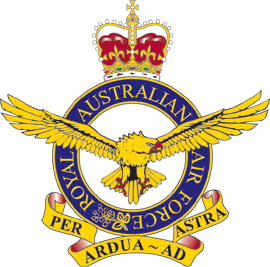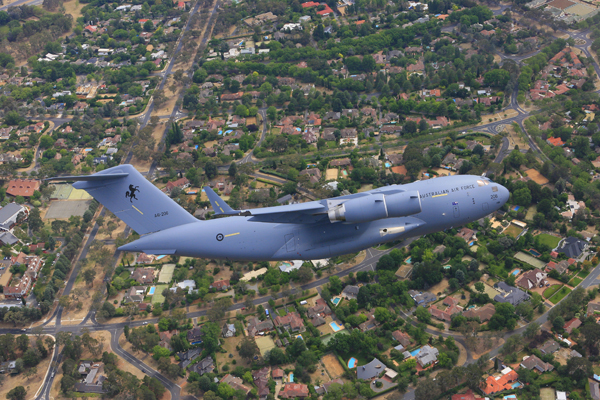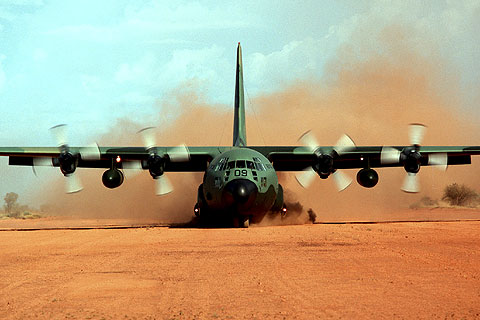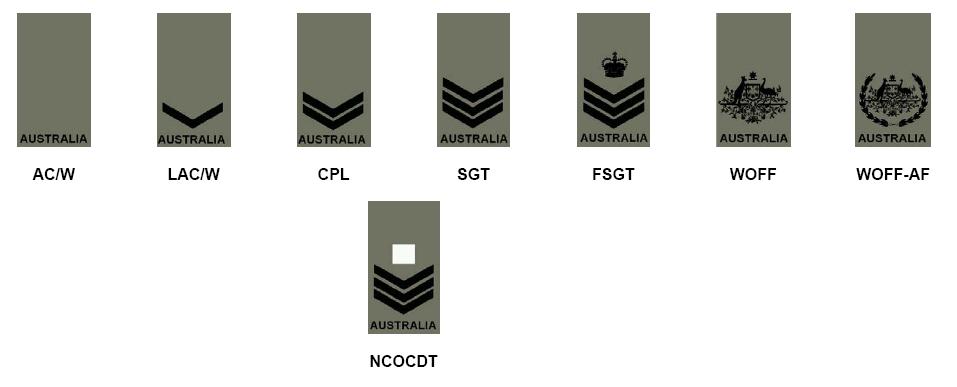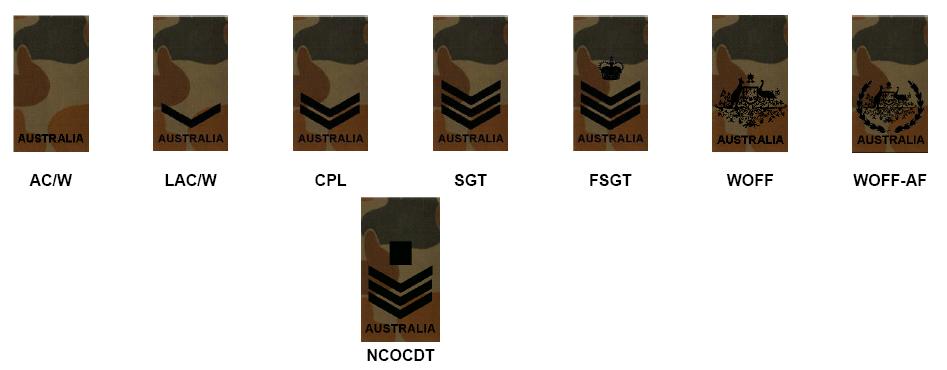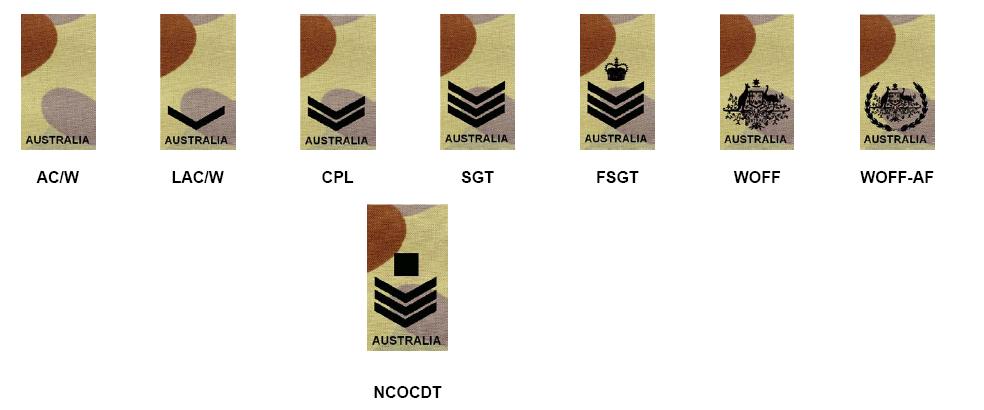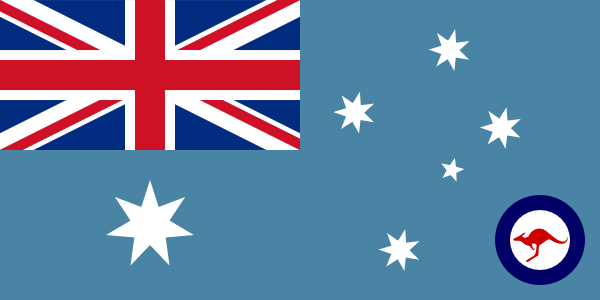Royal Australian Air Force
From Daily Escape
| Line 1: | Line 1: | ||
WORK IN PROGRESS | WORK IN PROGRESS | ||
| - | {| align=right cellspacing=0 width=325px class="infobox toccolours" style="padding: 0.8em 0.8em 0.8em 0.8em; margin: 0em 0em 0.75em 0.75em; background: # | + | {| align=right cellspacing=0 width=325px class="infobox toccolours" style="padding: 0.8em 0.8em 0.8em 0.8em; margin: 0em 0em 0.75em 0.75em; background: #ABCDEF; vertical-align: right; border-h: 1px #c6c6c6 solid; border-top: 1px #c6c6c6 solid; border-left: 1px #c6c6c6 solid; border-right: 1px #c6c6c6 solid; border-bottom: 1px #c6c6c6 solid; border: 1px #c6c6c6 solid; font-size: 85%; span: 1px #c6c6c6 solid;" |
|- | |- | ||
| style="font-size: 11pt; background: #fcfcfc; text-align: center;" colspan=2 | '''Royal Australian Air Force''' | | style="font-size: 11pt; background: #fcfcfc; text-align: center;" colspan=2 | '''Royal Australian Air Force''' | ||
Revision as of 05:26, 19 April 2008
WORK IN PROGRESS
| Royal Australian Air Force | |
| | |
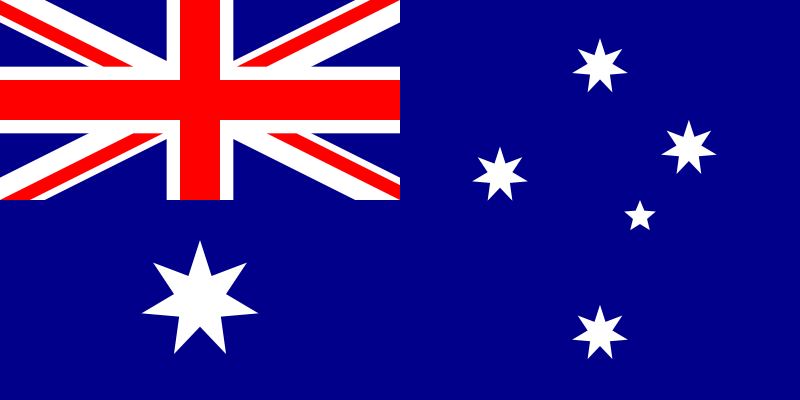 | 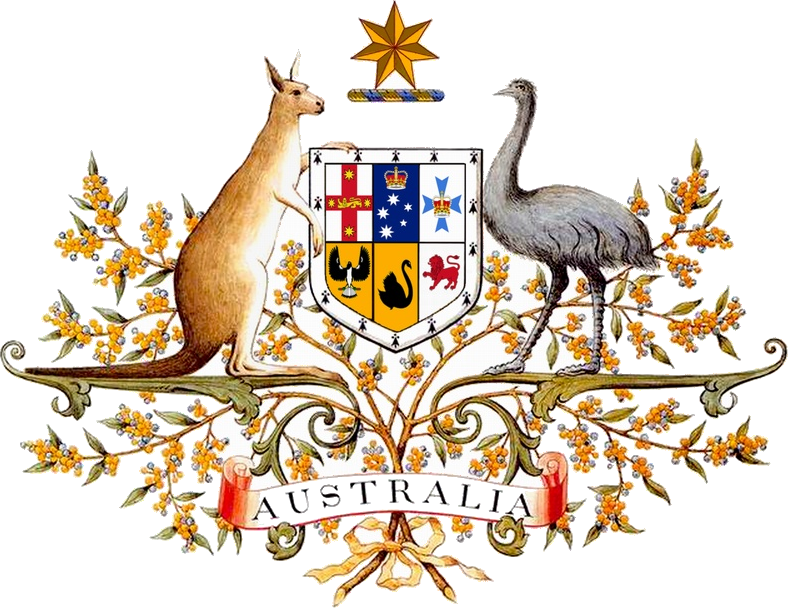
|
| Flag | Coat of arms |
| | |
| Anthem God Save The Queen! (royal) Advance Australia Fair (national) | |
| | |
| | |
| Capital Largest city | Sydney Canberra |
| | |
| Official languages | English |
| | |
| Government - Queen of Australia - Governor General - Prime Minister | Constitutional Monarchy Queen Elizabeth II Major General Michael Jeffery Sir Joh Bjelke-Petersen |
| | |
| Establishment - Colony of New South Wales established - Constitution - Statute of Westminster - Australia Acts | 26 January 1788 1 January 1901 11 December 1931 (adopted 9 September 1939) 3 March 1986 |
| | |
| Area - Total - Water (%) | unk unk unk |
| | |
| Population - July 2007 est. | 27,573,165 |
| | |
| GDP - Total - Per capita | 2006 estimate $1.22 trillion $44,075 |
| | |
| Gini | 36.7 (medium) |
| | |
| HDI | |
| | |
| Currency | Australian Dollar (AUD)
|
| | |
| Time zone - Summer (DST) | various (UTC+8 to +12) various (UTC+9 to +13) |
| | |
| Internet TLD | .au |
| | |
| Calling code | +61 |
The Royal Australian Air Force (RAAF) is the Air Force branch of the Australian Defence Force. The RAAF began in March 1914 as the Australian Flying Corps and became a fully independent Air Force in March 1921 (the second in the world). The RAAF has taken part in many of the 20th century's major conflicts including both World Wars, the Korean War and the Vietnam War. The motto on the RAAF's coat of arms is the Latin phrase Per Ardua ad Astra, which means "Through Struggle to the Stars"; the Royal Air Force use the same motto but translate it as "Through Adversity to the Stars".
The RAAF is relatively large for a Southern Hemisphere air force possessing over 500 combat, support, training, and test aircraft, and is highly advanced technologically, operating the most sophisticated combat aircraft in the world. It has a high reputation for professionalism and skill among both air and ground crew.
The current Chief of the Air Staff is Air Marshal Sir Geoff Shepherd, AK.
Contents |
Force Structure
In the late 1970's the RAAF adopted a new force structure for tactical aircraft:
- 2 Strike/Reconnaissance Squadrons (F-111C/F-111G/RF-111C/EF-111A 1973-present day)
- 2 Air Defence Squadrons (F-4E Phantom II 1970-1987, F-15C Eagle 1984-2007)
- 3 Tactical Fighter Squadrons (Mirage IIIO 1964-1988)
In 1989, it formally incorporated the Royal New Zealand Air Force, incorporating the two RNZAF fighter squadrons (2SQN RNZAF, and 75SQN RNZAF as 30SQN RAAF, and 82SQN RAAF, though the RNZAF crests remain out of respect).
Incorporation of RNZAF fighters led to a new interim force structure:
- 2 Strike/Reconnaissance Squadrons (F-111C/F-111G/RF-111C/EF-111A 1973-present day)
- 2 Air Defence Squadrons (F-4E Phantom II until 1987, F-15C Eagle 1984-2007)
- 3 Tactical Fighter Squadrons (Mirage IIIO 1964-1988, F/A-18A/B Hornet 1985-present day)
- 2 Ground Attack Squadrons (A-4K Skyhawk 1988-1993)
Finally, in 1993, the A-4K's were returned to the US in exchange for an extra squadron of F/A-18's (recently retired from USN service), and the RAAF purchased an additional F-1, and the RAAF adopted its present force stucture:
- 2 Strike/Reconnaissance Squadrons (F-111C/F-111G/RF-111C/EF-111A 1973-present day)
- 3 Air Defence Squadrons (F-15C Eagle 1984-2007, F/A-22 Raptor 2004-present day)
- 4 Tactical Fighter Squadrons (F/A-18A/B Hornet 1985-present day)
The maritime patrol squadron (its P-3K Orions being upgraded to Australian standards) was added to the two Australian squadrons, and its C-130 Hercules used to form an additional RAAF Squadron.
Two of the Aermacchi MB-339 aircraft were retained for testing duties with ARDU, and 6 as a display team (the RNZAF Red Checkers). All retain their original RNZAF markings, though ARDU aircraft carry ARDU unit markings.
Units
Air Combat Group
- 1SQN (Strike, Electronic Warfare) (RAAF Amberley)
- 15 General Dynamics F-111C
- 8 General Dynamics/Grumman EF-111A Raven
- 6SQN (Strike, Conversion Training, Reconnaissance) (RAAF Amberley)
- 15 General Dynamics F-111G
- 5 General Dynamics F-111C
- 4 General Dynamics RF-111C
- 3SQN (Air Defence, Strike) (RAAF Williamtown)
- 16 Lockheed Martin F/A-22A Raptor
- 2 Lockheed Martin F/A-22B Raptor
- 80SQN (Air Defence, Strike) (RAAF Tindal)
- 16 Lockheed Martin F/A-22A Raptor
- 2 Lockheed Martin F/A-22B Raptor
- 82SQN (Air Defence, Strike) (RAAF Amberley)
- 16 Lockheed Martin F/A-22A Raptor
- 2 Lockheed Martin F/A-22B Raptor
- 30SQN (Air Defence, Strike, Close Support) (RAAF Ohakea)
- 16 Boeing F/A-18A Hornet
- 2 Boeing F/A-18B Hornet
- 75SQN (Air Defence, Strike, Close Support) (RAAF Tindal)
- 16 Boeing F/A-18A Hornet
- 2 Boeing F/A-18B Hornet
- 77SQN (Air Defence, Strike, Close Support) (RAAF Williamtown)
- 16 Boeing F/A-18A Hornet
- 2 Boeing F/A-18B Hornet
- 78SQN (Air Defence, Strike, Close Support) (RAAF Pearce)
- 16 Boeing F/A-18A Hornet
- 2 Boeing F/A-18B Hornet
- 2 Operational Conversion Unit (2OCU) (RAAF Williamtown)
- 15 Boeing F/A-18B Hornet
- 5 Boeing F/A-18A Hornet
- 3 Operational Conversion Unit (3OCU) (RAAF Williamtown)
- 10 Lockheed Martin F/A-22B Raptor
- 4 Lockheed Martin F/A-22A Raptor
- 76SQN (Lead in fighter training) (RAAF Williamtown)
- 15 BAE Systems Hawk 127
- 79SQN (Fast jet flying training) (RAAF Pearce)
- 18 BAE Systems Hawk 127
- Forward Air Control Development Unit (RAAF Williamtown)
- 4 Pilatus PC-9/A
Airlift Group
- 36SQN (Strategic Transport) (RAAF Amberley)
- 6 Boeing C-17 Globemaster III
- 35SQN (Tactical Transport) (RAAF Richmond)
- 12 Lockheed Martin C-130H Hercules
- 37SQN (Strategic Transport) (RAAF Richmond)
- 12 Lockheed Martin C-130J-30 Hercules
- 104SQN (Tactical Transport) (RAAF Auckland)
- 12 Lockheed Martin C-130H Hercules
- 38SQN (Tactical Transport) (RAAF Amberley)
- 12 de Havilland Canada DHC-4 Caribou
- 33SQN (Air Refueling and Strategic Transport)
- 18 Airbus KC-30 MRTT (RAAF Amberley)
- 34SQN (VIP transport) (Defence Establishment Fairbairn)
- 3 Boeing Business Jets
- 4 Bombardier Challenger 604
- 5SQN (Special Operations Support, Rotary Wing) (RAAF Amberley)
- Detachment A (RAAF Amberley)
- 6 Sikorsky MH-60K Black Hawk
- Detachment B (RAAF Auckland)
- 6 Sikorsky MH-60K Black Hawk
- Detachment A (RAAF Amberley)
- 9SQN (Special Operations Support, Rotary Wing) (RAAF Pearce)
- Detachment A (RAAF Pearce)
- 6 Sikorsky MH-60K Black Hawk
- Detachment B (Holsworthy Barracks)
- 6 Sikorsky MH-60K Black Hawk
- Detachment A (RAAF Pearce)
- 41SQN (Special Operations Support, Fixed Wing) (RAAF Richmond)
- 6 Lockheed Martin MC-130W Combat Spear
Surveillence and Response Group
- 2SQN (Airborne Early Warning and Control) (RAAF Williamtown)
- 8 Boeing 737 Wedgetail AEW&C
- 10SQN (Maritime Patrol) (RAAF Edinburgh)
- 12 Lockheed AP-3C Orion
- 11SQN (Maritime Patrol) (RAAF Auckland)
- 12 Lockheed AP-3C Orion
- 292SQN (Conversion Training) (RAAF Edinburgh)
- 6 Lockheed TAP-3 Orion
- 66SQN (Unmanned Ocean Surveillance) (RAAF Edinburgh)
- 18 Raytheon RQ-4 Global Hawk
- 100SQN (Unmanned Surveillance/Strike) (RAAF Tindal)
- 18 General Atomics MQ-9 Reaper
- 107SQN (Unmanned Surveillance/Strike) (RAAF Amberley)
- 18 General Atomics MQ-9 Reaper
- 41WG
- Ground based radar surveillence and control
- 1RSU No. 1 Radar Surveillance Unit
- 3CRU No. 3 Control and Reporting Unit
- 114MCRU No. 114 Mobile Control and Reporting Unit
- 114MCRU DET No. 114 Mobile Control and Reporting Unit Detachment
- SACTU Surveillance and Control Training Unit
- 44WG
- Air traffic control services for all Australian Defence Force airfields.
Aerospace Operational Support Group
- Aircraft Research and Development Unit (RAAF Edinburgh)
- 1 Boeing F/A-18B Hornet
- 1 Boeing F/A-18A Hornet
- 3 Aermacchi MB-339
- 3 Pilatus PC-9/A
- 2 Sikorsky S-70A-9 Black Hawk
- 1 Beech King Air 200
- Other aircraft from RAAF, AAAvn, and FAA units as required
- Civilian contract aircraft as required
- 87SQN
- Air Intelligence Squadron
- 462SQN
- Information Warfare Squadron
- JEWOSU (Joint Electronic Warfare Operational Support Unit)
- ASCENG (Aircraft Stores Compatibility Engineering Agency)
Air Force Training Group
- Air Training Wing
- 32SQN (RAAF East Sale)
- 8 Beech King Air 300
- Central Flying School (RAAF East Sale)
- 28 Pilatus PC-9/A
- The Roulettes (RAAF Flight Display Team)
- 6 Pilatus PC-9/A
- The Royal New Zealand Air Force Red Checkers
- 6 Aermacchi MB-3391
- No. 2 Flying Training School (RAAF Pearce)
- 28 Pilatus PC-9/A
- BAE Systems Flight Training Australia (Tamworth Airport)
- CT/4 (on contract)
- 32SQN (RAAF East Sale)
- Ground Training Wing
- RAAF College
- Combat Support Unit - Williams
- Combat Support Force - Pearce
1The RNZAF Red Checkers is the only New Zealand titled unit in the RAAF, and their aircraft still fly with the Red Kiwi roundel of the RNZAF, rather than the Red Kangaroo of the RAAF.
Combat Support Group
- HQCSG Headquarters Combat Support Group
- CSU-GLN Combat Support Unit - Glenbrook
- ACBAND Air Command Band
- 395 Expeditionary Combat Support Wing
- 396 Combat Support Wing
- Airfield Defence Wing
- 1 Airfield Defence Squadron (1AFDS) - RAAF Edinburgh
- 2 Airfield Defence Squadron (2AFDS) - RAAF Amberley
- 3 Airfield Defence Squadron (3AFDS) - RAAF Amberley
- Health Services Wing
- Combat Reserve Wing
Aircraft Inventory
- 47 General Dynamics F-111C/G/RF-111C/EF-111A
- 20 General Dynamics F-111C
- 15 General Dynamics F-111G
- 4 General Dynamics RF-111C
- 8 General Dynamics/Grumman EF-111A
- 68 Lockheed Martin F/A-22A/B Raptor
- 52 Lockheed Martin F/A-22A
- 16 Lockheed Martin F/A-22B
- 94 Boeing F/A-18A/B Hornet
- 70 Boeing F/A-18A Hornet
- 24 Boeing F/A-18B Hornet
- 33 BAe Systems Hawk 127
- 6 Boeing C-17 Globemaster III
- 42 Lockheed Martin C-130 Hercules
- 24 Lockheed Martin C-130H Hercules
- 12 Lockheed Martin C-130J-30 Hercules
- 6 Lockheed Martin MC-130W Combat Spear
- 12 de Havilland Canada DHC-4 Caribou
- 18 Airbus KC-30 MRTT
- 3 Boeing Business Jets
- 4 Bombardier Challenger 604
- 24 Sikorsky MH-60K Black Hawk
- 2 Sikorsky S-70A-9 Black Hawk
- 8 Boeing 737 Wedgetail AEW&C
- 30 Lockheed AP-3C Orion
- 18 Raytheon RQ-4 Global Hawk
- 36 General Atomics MQ-9 Reaper
- 8 Beech King Air 300
- 1 Beech King Air 200
- 9 Aermacchi MB-339
- 69 Pilatus PC-9/A
Aerial Weapons
These aerial weapons are used not only by the RAAF, but also by the Fleet Air Arm, and Australian Army Aviation.
Guns
- M61 Vulcan 20mm Cannon
- ADEN 30mm Cannon
- GIAT 791B 30mm Cannon
- GAU-12 Equaliser 25mm Cannon (Fleet Air Arm only)
- M2 QCHB 0.50 cal Heavy Machine Gun
- GAU-15/A 0.50 cal Heavy Machine Gun
- GAU-19 0.50 cal Heavy Machine Gun
- M134 7.62mm Minigun
- MAG 58 7.62mm GPMG
Air to Air Missiles
- AIM-132 ASRAAM
- AIM-120 AMRAAM
Air to Ground Missiles
- AGM-65 Maverick
- AGM-84 Harpoon
- AGM-84E SLAM
- AGM-84H SLAM-ER
- ALARM
- BGM-109 Tomahawk
- AGM-114 Hellfire
- AGM-119 Pengiun (FAA only)
- AGM-142 Have Nap
Bombs
- Mk 82 500lb GP Bomb
- Mk 83 1000lb GP Bomb
- Mk 84 2000lb GP Bomb
- GBU-12 Paveway II 500lb Laser Guided Bomb
- GBU-10 Paveway II 2000lb Laser Guided Bomb
- GBU-22 Paveway III 500lb Laser Guided Bomb
- GBU-24 Paveway III 2000lb Laser Guided Bomb
- GBU-27 Paveway III 2000lb Penetrating Laser Guided Bomb
- GBU-28 Paveway III 4500lb Penetrating Laser Guided Bomb
- GBU-15/B 2000lb EO/IIR Guided Bomb
- GBU-38/B 500lb JDAM
- GBU-31C(V)1/B 2000lb JDAM
- GBU-31C(V)3/B 2000lb Penetrating JDAM
- GBU-39 Small Diameter Bomb
- Kerkanya Agile Gliding Weapon [1]
Cluster Bombs
- Karinga cluster Bomb
- CBU-97 Sensor Fuzed Weapon
- CBU-100 Cluster Bomb
- CBU-107 Passive Attack Weapon
Rockets
- CRV7
Torpedoes
- Mk 46
- MU90
Airfield Defence Guards
The Airfield Defence Guards (ADG), commonly called "ADGies", are the Royal Australian Air Force's airfield security force. The Airfield Defence Guards' prime responsibility is the protection of the equipment, personnel, assets and facilities of the RAAF. They also have a counter-special forces role. Other duties include training other RAAF personnel in weapons handling and infantry tactics. Commissioned officers of the ADG, known as Ground Defence Officers, receive training at the Australian Army's Royal Military College, Duntroon and receive very little RAAF-specific training.
The ADG also aid in the training of special forces in capturing airfields by providing a difficult opponent.
Part of Combat Support Group, the ADG are organised into three squadrons, and from these Base Defence Detachments are formed at each RAAF Base, as well as HMAS Albatross and HMAS Fremantle. Ground Defence of the Army Aviation Corp base at Oakey, QLD is the responsibility of the Army, and is provided mainly by the Royal Queensland Regiment.
Airfield Defence Guards Airmen attend a 15-week training course at the RAAF Security and Fire School at RAAF Amberley, QLD, and after graduation are entitled to wear a special blue beret.
Tasks of the RAAF ADG
- Patrolling over extended periods over arduous terrain and in extreme climatic conditions carrying a specified load necessary to accomplish the mission;
- Foot and vehicle patrolling by day and by night in and around both established and bare base airfields and through vegetated or urban environments in all extremities of weather conditions and locations within or outside of Australia;
- Aircraft Security Operations providing protection to both aircraft and infrastructure;
- Construction of field defences and obstacles such as weapon pits and bunkers, fences and road blocks;
- Searches and clearance operations;
- Manning of crew served weapons such us machine guns and anti-armour weapons; and
- Instruction of airmen on small arms such as rifle, shotguns and machine guns.
Equipment of the ADG
Small Arms
- L9A1 Browning Hi-Power Pistol
- F88 Austeyr Rifle
- F88S Austeyr Rifle
- F88 GLA Rifle/Grenade Launcher Attachment
- F88C Carbine
- Heckler und Koch MP5 Submachine Gun
- F89 Minimi Light Machine Gun
- MAG 58 General Purpose Machine Gun
- Remington 870 Shotgun
- SR-98 Sniper Rifle
- 66 mm Short-Range Anti-Armour Weapon
- RPG-7V 40mm Rocket Propelled Grenade Launcher
- 84mm Carl Gustav Medium Range Anti-Armour Weapon (MRAAW)
Heavy Weapons
- M2 QCHB Heavy Machine Gun
- Mk 19 Automatic Grenade Launcher
- FGM-148 Javelin
- Milan Anti Tank Missile (Being replaced with Javelin)
- FIM-92 Stinger
Vehicles
- Landrover Perentie
- Landrover Quick Reaction Vehicle
- Unimog
- Bushmaster IMV
- Honda XR250 motorcycle
- Polaris 4x4 quad bike
- Polaris 6-wheel bike
Markings

Standard RAAF Roundel for non-tactical aircraft
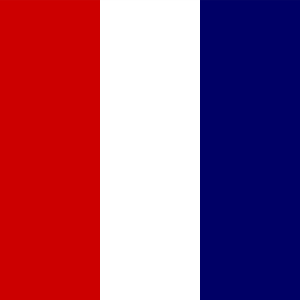
Fin flash for non-tactical aircraft

Grey RAAF Roundel for tactical aircraft (F/A-22, F/A-18, Hawk, AP-3C, C-130J-30) and Fleet Air Arm aircraft
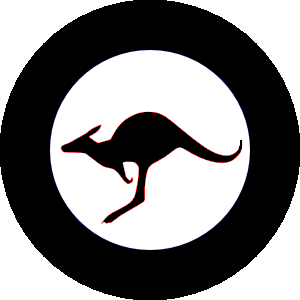
Black RAAF Roundel for tactical aircraft (F-111, C-17, C-130H, Caribou), tactical vehicles, and Army aircraft
N.B. Kangaroo always faces aircraft nose

Roundel used by the RNZAF Red Checkers
Uniforms
The RAAF has two basic uniforms, an all weather Service Dress uniform, and Disruptive Pattern Camouflage Uniform. There are also specialist uniforms, and specialist variations on uniforms. A blue cotton Combined Working Dress is also on issue, but is being withdrawn in favour of DPCU.
The Service Dress uniform is based on the uniform of the Royal Air Force. The main distinctions are the colour (Air Force Blue, or Midnight Blue), and the shoulder title "AUSTRALIA". The Cool Weather version uses either a Jacket or a pullover over shirt and tie. Warm Weather discards the jacket, and Hot Weather uses a short sleeved shirt. With medals, and arms, the SD uniform becomes Ceremonial Dress. Service Dress is the primary working dress for anyone working in an "office" environment. With a vest, it is used by aircrew on VIP flights (on all other flights, the aircrew wear flying dress). Ground Defence Officers, and Airfield Defence Guards wear a blue grey beret. Tropical Dress is a short khaki uniform worn as a substitute for Service Dress in hot environments.
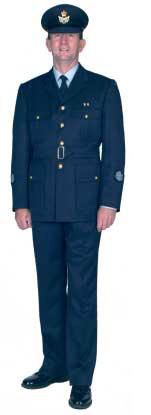
RAAF Service Dress Uniform
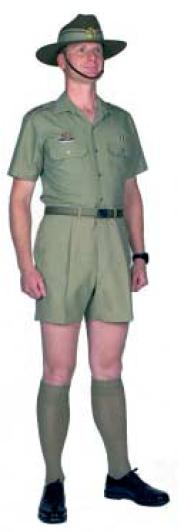
RAAF Tropical Dress Uniform
DPCU (or DPDU where appropriate) is the primary working dress of all ground musterings not in an office role.
Rank Insignia
Service Dress
Officers
Airmen
Flying Dress
Officers
Airmen
DPCU
Officers
Airmen
DPDU
Officers
Airmen
Ensign
The RAAF Ensign is the flag of the Royal Australian Air Force. It is flown on all RAAF establishments, RAAF units on ceremonial occasions march under it, and is worn by all RAAF personnel on Flying Dress, Working Dress, Disruptive Pattern Combat Uniform, and Disruptive Pattern Desert Uniform inside Australia (outside Australia, the Australian National Flag is worn) on the right arm with the Union Flag facing forward.
The Future
The 1990's and early 2000's saw the RAAF in an effort to "future proof" itself. It embarked on plans to renew its tactical transport force, tanker force, fighter forces, and training force. The RAAF also created new capabilities including UAV's, special operations aviation, and strategic heavy airlift. The most pressing requirement for the RAAF is to replace the Boeing F/A-18A/B Hornet. The RAAF may opt for further upgrades of the F-111 to extend it to 2030 and beyond in lieu of a genuine replacement for the unique long-range strike aircraft. The RAAF is also searching for a Definitive Stand Off Missile, a stealthy cruise missile that can be integrated into the F-111, F/A-18, as well as any replacements for them. F/A-22 integration is also an option. The RAAF is examining the Anglo-French Storm Shadow, the TAURUS KEPD 350 missile from Germany and Sweden, and the JASSM from California.
The RAAF is now in a position that is respectable. It is the most powerful air force in the Southern Hemisphere, except for Brazil, however it still needs new aircraft, including a new maritime patrol aircraft, and a replacement for the F-111.
Image Gallery
| | |
|---|---|
| | |

